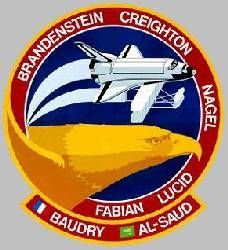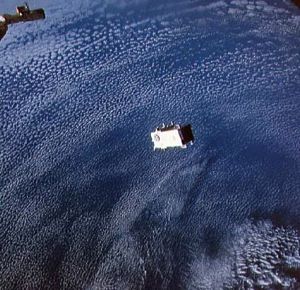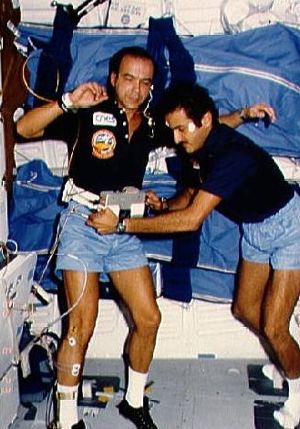
Home - Search - Browse - Alphabetic Index: 0- 1- 2- 3- 4- 5- 6- 7- 8- 9
A- B- C- D- E- F- G- H- I- J- K- L- M- N- O- P- Q- R- S- T- U- V- W- X- Y- Z
STS-51-G

STS-51-G
Astronaut John Creighton poses with onboard GRID computer
Credit: NASA
AKA: Discovery. Launched: 1985-06-17. Returned: 1985-06-24. Number crew: 7 . Duration: 7.07 days.
Deployed and retrieved Spartan 1; launched Morelos 1, Arabsat 1B, Telstar 3D.Payloads: Shuttle Pointed Autonomous Research Tool for Astronomy (SPARTAN)-1; Automated Directional Solidification Furnace (ADSF); High Precision Tracking Experiment (HPTE); Orbiter Experiments (OEX); French Echocardiograph Experiment (FEE) and French Pocket Experiment (FPE).
Orbits of Earth: 111. Distance traveled: 4,693,051 km. Orbiter Liftoff Mass: 116,310 kg. Orbiter Mass at Landing: 92,607 kg. Payload to Orbit: 20,174 kg. Payload Returned: 9,818 kg. Landed at: Runway 23 dry lake bed at Edwards Air Force Base, . Landing Speed: 366 kph. Touchdown miss distance: 340 m. Landing Rollout: 2,265 m.
NASA Official Mission Narrative
Mission Name: 51-G (18)
DISCOVERY (5)
Pad 39-A (30)
18th Shuttle mission
5th Flight OV-103
Crew:
Daniel C. Brandenstein (2), Commander
John O. Creighton (1), Pilot
Shannon W. Lucid (1), Mission Specialist 1
John M. Fabian (2), Mission Specialist 2
Steven R. Nagel (1), Mission Specialist 3
Patrick Baudry (1), Payload Specialist 1
Sultan Salman Al-Saud (1), Payload Specialist 2
Milestones:
OPF - April 19, 1985
VAB - May 29, 1985
PAD - June 4,1985
Payload:
MORELOS-A,ARABSAT-1B,TELSTAR-3D,SPARTAN-1,FEE,FPE,ADSF
Mission Objectives:
Launch:
Jun. 17,1985,7:33:00 a.m, EDT. Launch proceeded as scheduled with no delays. Launch Weight: 256,524 lbs.
Orbit:
Altitude: 209nm
Inclination: 28.45 degrees
Orbits: 112
Duration: Seven days, one hour, 38 minutes, 52 seconds.
Distance: 2,916,127 miles
Hardware:
SRB: BI-019
SRM: M018(HPM)
ET : 20/LWT-13
MLP : 1
SSME-1: SN-2109
SSME-2: SN-2018
SSME-3: SN-2012
Landing:
June 24, 1985, 6:11:52 a.m. PDT, Runway 23, Edwards Air Force Base, Calif. Rollout distance: 7,433 feet. Rollout time: 42 seconds. Orbiter returned to KSC June 28, 1985. Landing Weight: 204,169 lbs
Mission Highlights:
Three communications satellites, all attached to Payload Assist Module-D (PAM-D) motors, were deployed: MORE LOS-A, for Mexico; ARABSAT-A, for Arab Satellite Communications Organization; and TELSTAR-3D, for AT&T. Also flown: deployable/retrievable Shuttle Pointed Autonomous Research Tool for Astronomy (SPARTAN-1); six Get Away Special canisters; Strategic Defense Initiative experiment called the High Precision Tracking Experiment (HPTE); a materials processing furnace called Automated Directional Solidification Furnace (ADSF); and two French biomedical experiments.
More at: STS-51-G.
Family: Manned spaceflight. People: Al-Saud, Baudry, Brandenstein, Creighton, Fabian, Lucid, Nagel. Country: USA. Spacecraft: Discovery. Projects: STS. Launch Sites: Cape Canaveral. Agency: NASA, NASA Houston. Bibliography: 4457.
 | STS-51-G Credit: www.spacefacts.de |
 | STS-51-G Spartan 1 satellite moves away from orbiter over ocean Credit: NASA |
 | STS-51-G Arabsat communications satellite deploying from Discovery's payload bay Credit: NASA |
 | STS-51-G Astronaut Shannon Lucid monitors payload bay activities Credit: NASA |
 | STS-51-G Payload specialists Baudry and Al-Saud conduct Postural experiment Credit: NASA |
 | STS-51-G Wadi Habawnah, Saudi Arabia Credit: NASA |
1985 June 17 - . 11:33 GMT - . Launch Site: Cape Canaveral. Launch Complex: Cape Canaveral LC39A. Launch Platform: MLP1. LV Family: Shuttle. Launch Vehicle: Space Shuttle.
- STS-51-G - .
Call Sign: Discovery. Crew: Al-Saud,
Baudry,
Brandenstein,
Creighton,
Fabian,
Lucid,
Nagel.
Payload: Discovery F05 / Morelos 1[PAM-D] / Telstar 303. Mass: 20,174 kg (44,476 lb). Nation: USA.
Related Persons: Al-Saud,
Baudry,
Brandenstein,
Creighton,
Fabian,
Lucid,
Nagel.
Agency: NASA Houston.
Program: STS.
Class: Manned.
Type: Manned spaceplane. Flight: STS-51-G.
Spacecraft Bus: Shuttle.
Spacecraft: Discovery.
Duration: 7.07 days. Decay Date: 1985-06-24 . USAF Sat Cat: 15823 . COSPAR: 1985-048A. Apogee: 369 km (229 mi). Perigee: 358 km (222 mi). Inclination: 28.50 deg. Period: 91.80 min.
Deployed and retrieved Spartan 1; launched Morelos 1, Arabsat 1B, Telstar 3D.Payloads: Shuttle Pointed Autono-mous Research Tool for Astronomy (SPARTAN)-1; Automated Directional Solidification Furnace (ADSF); High Precision Tracking Experiment (HPTE); Orbiter Experiments (OEX); French Echocardiograph Experiment (FEE) and French Pocket Experiment (FPE).
1985 June 18 - .
- STS-51-G - Wakeup Song: I Feel the Earth Move - . Flight: STS-51-G. "I Feel the Earth Move" by Carole King CAPCOM: Bob Springer.
1985 June 21 - .
- STS-51-G - Wakeup Song: Proud Mary - . Flight: STS-51-G. "Proud Mary" by Creedence Clearwater Revival CAPCOM: David Leetsma.
1985 June 22 - .
- STS-51-G - Wakeup Song: Sailing - . Flight: STS-51-G. "Sailing" by Christopher Cross CAPCOM: David Leetsma.
1985 June 23 - .
- STS-51-G - Wakeup Song: Jonathan Livingston Seagull - . Flight: STS-51-G. "Jonathan Livingston Seagull" Theme from movie by Neil Diamond;Untitled Saudi Arabian music; (First Wakeup). CAPCOM: David Leetsma Second Wakeup:"Happy Talk" from movie"South Pacific" . CAPCOM: Bob Springer.
1985 June 24 - .
- STS-51-G - Wakeup Song: William Tell Overture - . Flight: STS-51-G. "William Tell Overture" by Rossini 2."Wedding March" by Felix Mendelssohn 3."Get Me to the Church on Time" from"My Fair Lady" by Lerner and Loewe. In honor of pilot John Creighton's upcoming marriage CAPCOM: David Leetsma.
1985 June 24 - .
- Landing of STS-51-G - . Return Crew: Al-Saud, Baudry, Brandenstein, Creighton, Fabian, Lucid, Nagel. Nation: USA. Related Persons: Al-Saud, Baudry, Brandenstein, Creighton, Fabian, Lucid, Nagel. Program: STS. Flight: STS-51-G. STS-51-G landed at 13:10 GMT. .
Back to top of page
Home - Search - Browse - Alphabetic Index: 0- 1- 2- 3- 4- 5- 6- 7- 8- 9
A- B- C- D- E- F- G- H- I- J- K- L- M- N- O- P- Q- R- S- T- U- V- W- X- Y- Z
© 1997-2019 Mark Wade - Contact
© / Conditions for Use